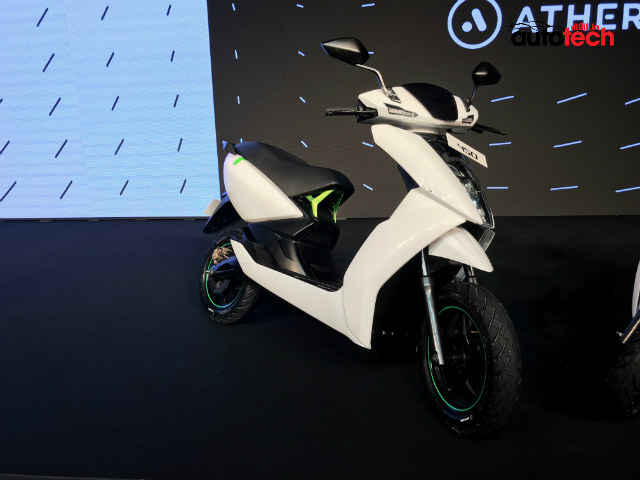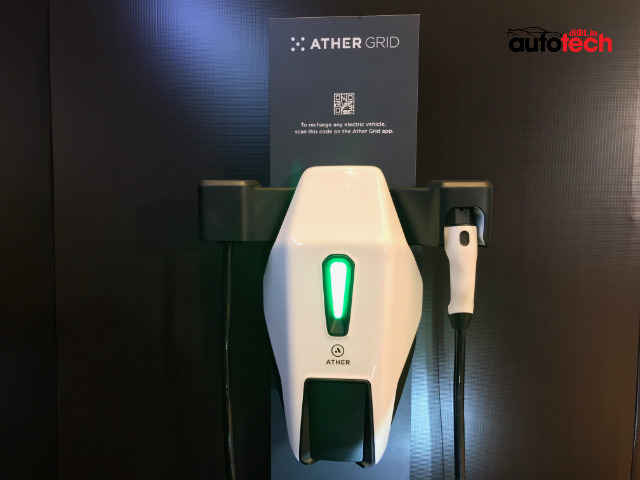First Impressions: Ather S340 and 450, smart electric scooters from Indian startup Ather Energy

Ather Energy has long-term plans, which begin with its smart, electric scooters - the Ather 340 and 450. This, however, is only a prelude.
The Indian startup industry has been been steadily seeing the rise of startups working on electric two-wheelers. Ather Energy has been one of the most talked-about names in this space, that also has the likes of Emflux, Tork, Twenty Two Motors and Okinawa all vying for a headstart in the field of all-electric two-wheelers. While some have been working on electric bikes, the rest are putting their initial investment into short-range scooters for in-city commuting.
For Ather Energy, the start of its journey has been with scooters. The company recently unveiled its first two scooters, when everyone expected it to unveil just one. The two are essentially built on the same chassis and platform, but differ in terms of their electric motors and batteries. The Ather 340 is the one that was shown at Rise Conference in Bengaluru, in 2016. While the company did indeed begin its launch with the Ather 340, the Ather 450 is the one that is the company’s startup, and will presumably sell more.
The scooters
The Ather 340 and 450 are nearly identical in terms of design, saving the green ring around the wheels of the 450. The overall design is quite smart and sharp, with a freshness quotient that most city commuters wouldn’t mind at all. The scooters are both made of machined aluminium and steel hybrid chassis, with the battery placed on the floorboard and the electric motor up front.
The Ather 340 delivers 5.9 bhp of peak power and 20 Nm torque, while the 450 delivers 7.3 bhp and 20.5 Nm torque. The difference that this leads to is 70 kmph top speed on the Ather 340, and 80 kmph on the Ather 450. Acceleration times are also different, with the Ather 340 hitting 40 kmph in 5.1 seconds and the Ather 450 achieving the same in 3.9 seconds. The difference in powertrain also affects gradeability, with the Ather 340 rated at 15 degrees and the Ather 450 capable of scaling 18-degree inclines.
The overall range is also different between the two, with the Ather 340 rated at 60 km range from one full charge cycle in ‘Eco’ mode, while the Ather 450 is rated at 75 km. As per ARAI testing figures, the same cycle is rated at 107 km in the Ather 450. The 51.1V Li-ion battery provides 1.92 kWh of usable power to the Ather 340, and 2.4 kWh to the Ather 450. The battery can be hooked up to a standard 5A plug at home, and two hours and 40 minutes to charge up to 80 percent, and four hours and 18 minutes for full charge. With the Ather Grid fast charging mode, the charging rate is specified at 1 km/minute, which should take about one hour and 15 minutes in the Ather 450 at the longest.
Both the scooters run on 12-inch wheels with tubeless tyres, and are equipped with CBS (Combined Braking System) to aid safety. The scooters are also equipped with standard regenerative braking to facilitate charge recovery while on road. The headlamp, tail lights and indicators are LED, with active turn indicators also doubling up as DRLs. Ather Energy has also accounted for the on-road wear and damage possibilities, with IP66-rated protection on the electric motor, IP65 on the central controller, an aluminium alloy casing and IP67 protection on the battery, and IP65 protection from water and dust on the digital display.
The technology package
At the centre of the dashboard is a 7-inch, 800×480-pixel display that looks crisp and bright. It is touch-enabled, but restricts touch-based usage at speeds above 2 kmph. The interface is cleverly-designed, and accounts for the much-deliberated issue of rider distraction. The system is built on Linux, with a proprietary interface. At the heart of the interface is the Home screen, which displays a digital speedometer, total range left and an Eco mode toggle, along with an odometer, a trip meter and average speed of trip to the left.
To the top left is a hamburger icon that allows you to access its menu, a signal strength indicator for the pre-installed SIM card capable of 3.5G HSPA connectivity speeds, digital time display and motor on/off indicator, and a navigation shortcut to access the map. The interface allows you to set up your own profile, and there is a limited internal storage onboard that synchronises with the smartphone app to store your documents in the digital format. For instance, you can upload digital copies of your scooter’s registration certificate, insurance and road tax data, along with a copy of your rider’s licence for easy access.
There is also a notification panel for showing errors pertaining to the scooter. The navigation system is powered by Google, and operates in two ways. When on the move, you can feed your destination of travel via Ather’s smartphone app, and the scooter’s onboard system syncs from your phone. Otherwise, when stationary, you can add location and destination data via the touchscreen interface. The display also shows the Park Assist mode, which activates when you activate reverse gear. The speed of the reverse mode is limited to 2 kmph, but can make parking and reversing much easier with the power input.
The full interface is capable of receiving over-the-air updates via the smartphone app or natively, thanks to the integrated connectivity. The integrated internet connection also makes the Ather 340 and 450 future-proof for connected vehicle infrastructure, and the interface has plenty of room to add features as we progress through safety norms. This will also help keep the scooters relevant and updated in the future, adding a level of assurance to potential buyers. Roadside assistance can also be accessed via the connected system, and geotagging and geofencing can also be enabled for smart safety.
The interface has a level of maturity that is pleasant to see. Using the system is really easy, and on overall terms, the Ather digital cluster is a versatile unit that has been designed keeping the future in mind. This will also come into play once India’s smart cities begin flourishing. Ather Energy’s technology package also includes a killswitch, DRLs doubling up as indicators, LED-lit storage area underneath the seat, and 51:49 weight distribution ratio.
Pricing and Ather One
The Ather 340 is priced at Rs. 1,09,750 (all inclusive), while the Ather 450 is priced at Rs. 1,24,750. Pre-orders are now open for Bengaluru, and deliveries will commence from August. Ather Energy presently has plans to expand its service areas to Chennai and Pune by end-2018, while long term expansions plans extending to end-2019 include Hyderabad, Delhi and Mumbai.
At the centre of its scooters is Ather’s all-inclusive plan – Ather One. With Ather One, Ather covers almost every bit of your running cost. This subscription plan includes unlimited charging at public AtherGrid stops, reimbursement of cost incurred while charging at home (reimbursed to a linked e-wallet), free service and maintenance all through subscription tenure, 24×7 roadside assistance and unlimited data plan including navigation, vehicle diagnostics and remote services. The cost for this service is Rs. 700 per month, which may well be a massive point of attraction for potential buyers.
AtherGrid
Think of AtherGrid as Ather’s equivalent of the Tesla Supercharger. AtherGrid is a fast charging station that links to Ather’s proprietary port, and can also be installed at home. Interestingly, AtherGrid is a prelude to the company’s potential future expansion plans, since it allows any electric vehicle to connect to its station via standard 5V/5A charging cables. Payment can be done through the AtherGrid app on iOS and Android smartphones.
It is this that the company aims to expand on, and this that will also allow the startup to grow into an energy service, mimicking Tesla’s model albeit on a smaller scale for now. At its launch, Tarun Mehta, CEO Ather Energy stated that while the thought of considering energy services as a standalone business line has indeed been brought up, it is one for the long term future, and they will focus only on electric scooters as of now. To build its presence, Ather Energy is offering the first six months of charging any electric vehicle for free, once you sign up through the AtherGrid app. For any Ather vehicle, the charging station will be free and Ather’s scooters will be auto-authenticated. At present, AtherGrid is present across 15 public stations across Bengaluru, with more stations in plans.
Ather Energy has made a solid start to its journey with AtherGrid and its two smart electric scooters – the Ather 340 and the Ather 450. It now remains to be seen how its journey continues, and how far the startup manages to deliver in its promises.










